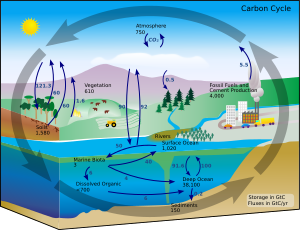| This carbon cycle diagram shows the storage and annual exchange of carbon between the atmosphere, hydrosphere and geosphere in gigatons - or billions of tons - of Carbon (GtC). Burning fossil fuels by people adds about 5.5 GtC of carbon per year into the atmosphere. (Photo credit: Wikipedia) |
by Alan Pears, Senior Lecturer, Global Studies, Social Science & Planning at RMIT University, The Conversation: http://theconversation.edu.au
Some critics of carbon pricing have pointed out that, over time, the carbon price will increase to a much higher level and devastate the economy.
Indeed, the image of a python squeezing the life out of the economy has been painted to describe this.
However, this view is based on a misunderstanding of how carbon pricing works, and confusion over the difference between the price per unit of carbon and the overall impact on household and business costs.
Most analysts expect the carbon price to increase over time as the “low hanging fruit” of abatement options is captured and we have to adopt more expensive ways (such as carbon capture and storage and costly forms of renewable energy) to make deeper emission cuts. By 2050, many estimates indicate the price might exceed $150 per tonne.
However, at the same time, the greenhouse intensity of energy, goods, and services will decline as businesses and households act to cut their emissions. This will reduce the impact of a higher carbon price per tonne on total carbon costs experienced by consumers.
For example, Treasury expects the greenhouse intensity of Australian electricity to fall by over three-quarters by 2050, as renewable energy and gas replaces coal fired power. On top of this, we will be more energy efficient, so we will use less electricity to deliver each service such as lighting, comfort, refrigeration, and so on.
Emissions down, efficiency up: carbon price will be offset
So if the greenhouse intensity (emissions per kilowatt-hour) of electricity falls by three-quarters, and we use, say, 30% less electricity per unit of service by becoming more energy efficient, the carbon price could increase to almost six times today’s price while having no more impact on a consumer’s overall electricity costs than today’s carbon price.
To read further, go to: http://theconversation.edu.au/why-the-carbon-tax-python-wont-squeeze-the-economy-8375?utm_medium=email&utm_campaign=Latest+from+The+Conversation+for+25+July+2012&utm_content=Latest+from+The+Conversation+for+25+July+2012+CID_b49002df34cf748462671bfce46b6c91&utm_source=campaign_monitor&utm_term=Why+the+carbon-tax+python+wont+squeeze+the+economy


No comments:
Post a Comment